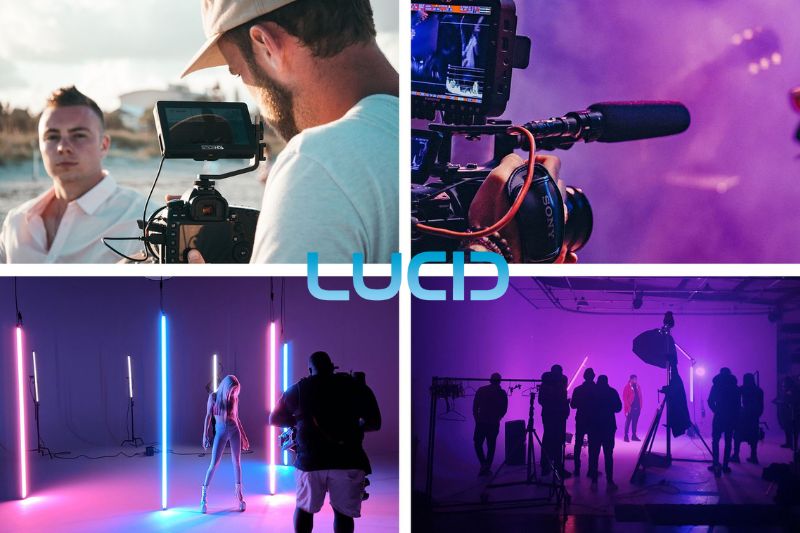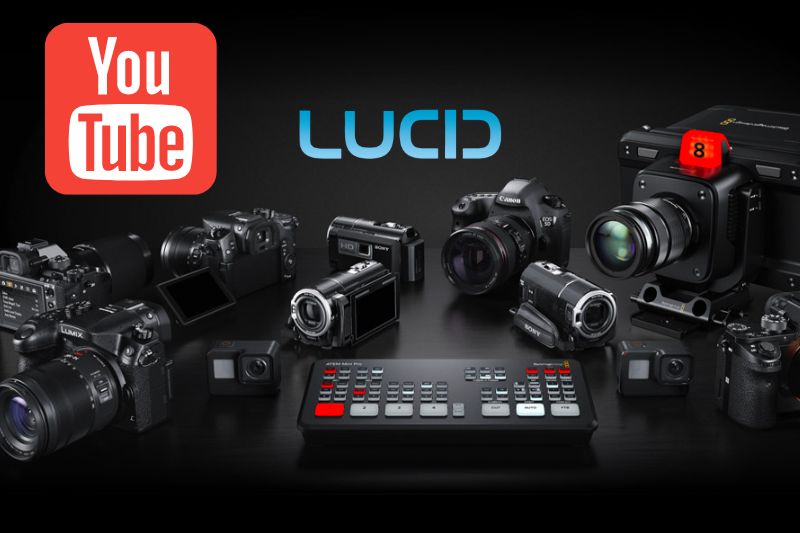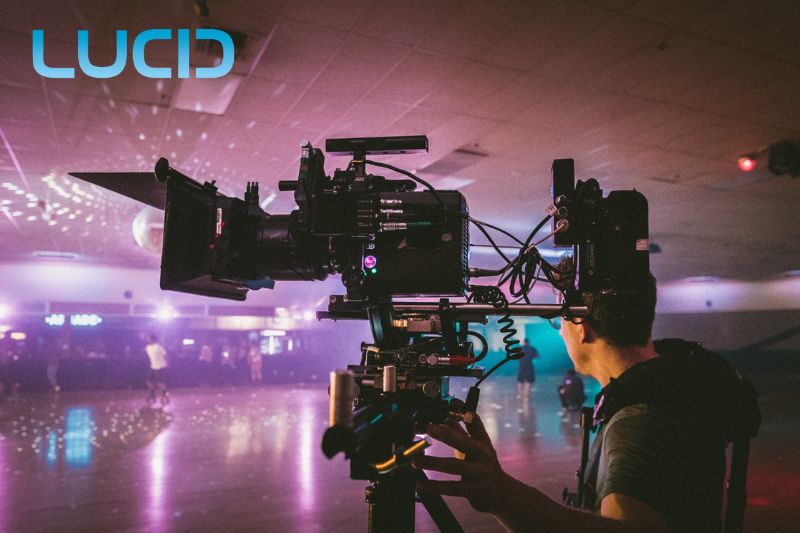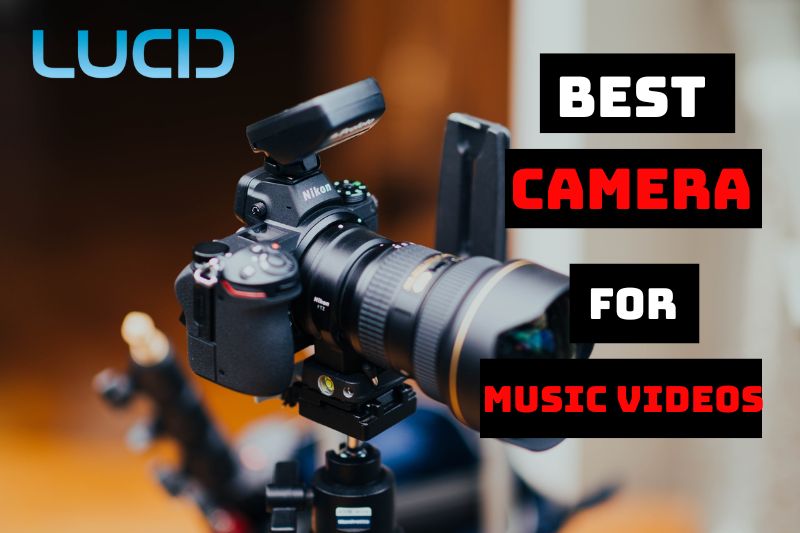Are you a musician looking for the best camera for music videos? It’s really hard to choose camera fit for you because there are so many products on the market. In this article, Lucidcam will help you find the best camera for making music videos and give you some tips when you pick camera.
Table of Contents
- 1 What Makes Music Videos Different?
- 2 Top 10 Best Cameras For Music Videos In 2023
- 2.1 Sony A6400
- 2.2 Panasonic Lumix DC-S1H
- 2.3 Nikon D780 – Best video camera for live bands
- 2.4 Panasonic LUMIX GH5 II- Best video camera for musicians
- 2.5 Blackmagic Pocket Cinema Camera 6K Pro- Best Camera To Record Home Videos
- 2.6 Fujifilm XT-4
- 2.7 Canon EOS R6
- 2.8 Sony A7S III- Best Cameras For Shooting Videos
- 2.9 Sony FDR-AX43
- 2.10 Panasonic Lumix DMC-LX5
- 3 Whats a good camera for youtube?
- 4 FAQs
- 5 Conclusion
What Makes Music Videos Different?

Cameras for music videos are very important to make a fun and pretty video. Music videos focus on people singing and dancing, not on telling a story.
The camera should catch how the singer feels and looks, and make the video interesting for people watching.
Special cameras for music videos can do cool things like work well in the dark, make the singer’s moves look smooth, and show pretty lights on stage.
These cameras make the video look like a movie and can make it very clear and nice.
They should be easy to carry, simple to use, and work well with computer programs for making videos.
Filmmakers and singers have different ideas, so it’s important to pick a camera that helps them make the video they want.
A good music video camera should help make the video look amazing and show the singer’s ideas.
Top 10 Best Cameras For Music Videos In 2023

Sony A6400
Pros:
- Excellent autofocus system with 425 phase-detection autofocus points that cover 84% of the frame.
- High-quality image and video performance
- 4K video recording capabilities with the ability to shoot slow-motion footage at up to 120fps in Full HD.
- Flip-up touchscreen that makes it easy to monitor your shots while filming.
- The compact and lightweight design
- Built-in microphone jack for recording high-quality audio.
- Advanced subject-tracking capabilities make it easy to capture fast-moving subjects with accuracy and precision.
- A wide range of customizable settings and presets
Cons:
- Lacks in-body image stabilization (IBIS).
- Limited battery life, with a single charge lasting only around 410 shots.
- No headphone jack for monitoring audio while recording.
- Limited touchscreen functionality when it comes to navigating menus and settings.
- Limited weather sealing makes it less suitable for shooting in harsh or extreme conditions.
The Sony A6400 is a cool camera that takes great pictures and videos, and it’s not too expensive.
This camera is made for people who make videos or vlogs because it can take 4K videos and has a screen that flips up to help you see what you’re filming.
It also takes nice photos with its 24.2-megapixel part and a special system that helps it focus quickly.
The focusing system is really good at finding what you want to take a picture of, even if it’s moving fast.
The Sony A6400 has other fun things, like taking slow-motion videos, a place to plug in a microphone, and settings to make your videos look just how you want them.
The Sony A6400 is a great camera for people who want a camera with reasonable
If you like making videos or taking pictures, this camera could help you do even better.
[amazon box=”B07MV3P7M8″ template=”horizontal”]Panasonic Lumix DC-S1H
Pros:
- Exceptional image quality, capable of shooting 6K footage at 24 frames per second
- Wide dynamic range, retaining detail in bright and dark areas of the scene
- Excellent in-body image stabilization (IBIS) system, providing steady footage even when shooting handheld
- Manual control of shutter angle for more creative control over footage
- Robust weather-sealed body, ideal for use in harsh environments
- Large OLED electronic viewfinder for accurate framing even in bright sunlight
- Dual memory card slots for seamless backup and uninterrupted shooting
Cons:
- Expensive, priced higher than some other full-frame mirrorless cameras on the market
- Relatively heavy and bulky
- Limited lens selection compared to other camera brands due to Panasonic’s L Mount alliance
- Rolling shutter performance could be improved for fast-moving subjects or handheld shots.
The Panasonic Lumix music video camera 4k is a special camera for people who make movies and videos for their job. It takes really good pictures and videos that look like they were made by a movie camera!
This camera is also good at showing all the different parts of a picture or video, even some parts are really bright or really dark. It can even help you hold the camera still, so your videos and pictures don’t look shaky.
This camera also lets you be creative with your videos by changing the angle of the flash. And it’s really strong and can work even in bad weather.
You can take numerous photos and videos with this camera without having to stop and switch memory cards. It’s a ideal choice for people who want a camera that can do lots of different things!
[amazon box=”B07YD8MLLJ” template=”horizontal”]Nikon D780 – Best video camera for live bands
Pros:
- Excellent hybrid autofocus system, borrowed from Nikon’s mirrorless Z6 camera
- Can shoot beautiful 4K video at up to 30 fps, and 1080p full HD video at up to 120 fps
- Dual memory card slots for backup and overflow
- Wide ISO range, up to 51200, providing low-light performance
- Large and bright optical viewfinder
- Weather-sealed body for shooting in harsh conditions
- Maintains compatibility with Nikon’s extensive lineup of F-mount lenses
Cons:
- Relatively heavy and bulky, compared to mirrorless options
- No in-body image stabilization (IBIS), relying on lens stabilization instead
- Limited autofocus coverage when shooting through the optical viewfinder
- LCD screen is not fully articulating, making it less versatile for video recording
- No USB-C port, only offering USB 2.0 connectivity
- Rolling shutter effect can occur when recording video, especially at higher frame rates
The Nikon D780 is a useful camera that takes great photos and videos.
It has a 24.5-megapixel part for taking pictures and can take 7 photos very fast, which is great for pictures of animals or sports.
The D780 has a special focusing system that helps take clear photos and videos, even if what you’re looking at is not in the middle of the picture.
For videos, the D780 can take very clear 4K videos and slow-motion videos too.
Additionally, it is possible to modify the video’s colors post-capture, and transfer it to another device using a designated cable.
The camera features two memory card slots, can be used in rain or snow, and has a huge viewfinder to assist you see what you’re photographing.
If you already have Nikon lenses, this camera can use them too.
[amazon box=”B083K41K2S” template=”horizontal”]Panasonic LUMIX GH5 II- Best video camera for musicians
Pros:
- Excellent video recording capabilities, including support for 10-bit internal 4K at up to 60fps and 4:2:2 subsampling.
- Full-sized HDMI port for connecting to external recorders and monitors.
- Good dynamic range and color accuracy in both photos and videos.
- Dual card slots for added convenience and flexibility.
- Robust autofocus system that is fast and accurate.
- Flip-out touchscreen for easy framing and monitoring.
Cons:
- The micro four-thirds sensor may struggle in low-light situations compared to larger sensors.
- The camera is relatively expensive compared to some other entry-level mirrorless cameras.
- The design and layout of the controls may not be as intuitive for some users.
One of the best 4k video cameras is the Panasonic Lumix GH5 II. It’s a great camera for both taking pictures and making movies. It’s especially good for beginners who want a small, high-quality camera with advanced video features.
The video camera has a 20.3 MP sensor, which is considered by many to be one of the best micro four-thirds cameras on the market. It has a wide dynamic range and great picture quality, but it doesn’t work as well in low-light conditions.
One of the most impressive things about the GH5 II is how well it can take video. The camera can handle up to 60 frames per second in 10-bit internal 4K with 4:2:2 subsampling, which lets it capture great detail and accurate colors.
The camera has a microphone input, a headphone jack, and a full-sized HDMI port for linking to external recorders and viewers.
The GH5 II is a great choice for both shooters and makers because it has advanced video features and a lot of features that make life easier.
The camera has a touchscreen that you can flip out to make focusing and tracking easy. It also has a strong autofocus system that works quickly and accurately. It also has two card slots to make things easier and give you more options.
[amazon box=”B09BZR7V6G” template=”horizontal”]Blackmagic Pocket Cinema Camera 6K Pro- Best Camera To Record Home Videos
Pros:
- Ability to capture high-quality videos in 6K and 4K with 12-bit B-RAW and 10-bit ProRes codecs.
- Compatibility with a wide range of lenses from Canon, Sigma, Zeiss and others.
- Built-in ND filters, XLR audio inputs, and long battery life.
- Super 35 sensor is commonly used in the film industry.
- High level of customization and control over video settings.
- Robust and durable body construction.
Cons:
- Requires a high level of technical skill and experience to operate effectively.
- No continuous autofocus or image stabilization.
- The camera is quite heavy and may require additional support music video equipment.
- Large file sizes consume significant storage space and require powerful hardware for editing and post-production.
- Expensive compared to other cameras in its class.
The Blackmagic Pocket Cinema Camera 6K Pro is a really cool camera for people who make movies , especially music videos. It can take super amazing pictures and videos that look like they were made by a fancy movie camera! It has a lot of awesome features that make the pictures and videos really detailed and special.
This camera is super cool because it has a special sensor that makes the pictures and videos look really nice. You can also use different lenses with this camera to make the pictures and videos look different, which is really neat!
The camera also has something called ND filters that make sure the pictures and videos don’t look too bright when you’re filming outside in the sun. It can work for a long time on one battery and it’s really strong.
But, this camera is not easy to use. It’s best for people who know how to use a camera really well and don’t need the camera to do everything for them. If you want to make really good, professional-looking music videos, this camera is a great choice!
[amazon box=”B08WYJL4RY” template=”horizontal”]Fujifilm XT-4
Pros:
- Beautiful retro design with a weather-resistant body and fully-articulating touchscreen.
- It can shoot 10-bit footage in 4K at 60 fps and 240 fps at 1080p, offering high-quality slow-motion capabilities.
- In-body image stabilization eliminates the need for a gimbal and produces professional results.
- Excellent autofocus system with advanced tracking and face detection.
- A wide range of high-quality lens options is is available from Fujifilm.
Cons:
- Battery life could be better, especially when shooting in 4K.
- Limited autofocus performance in low-light conditions.
- The menu system can be complicated and overwhelming for new users.
- No built-in headphone jack, requiring an external audio recorder for monitoring audio.
- No built-in ND filter, requiring external filters to be attached for shooting in bright sunlight.
It has a beautiful, weather-resistant body with retro knobs and a touchscreen that can move in all directions. This makes it fun to use and lets you take pictures from different angles.
The camera can shoot 10-bit video in 4K at 60 frames per second, which shows how good it is at making videos. Also, the camera can shoot slow-motion Full HD video at an amazing 240 fps, which is great for getting high-quality footage for music videos.
One of the biggest improvements over its predecessor is that it has image stabilization built right into the body. This means that you don’t need a gimbal to make videos that look professional.
The cheap music video camera also has a variety of filters that are made for video use. This makes it a powerful and flexible tool for making music videos.
Even though there are other options on the market, like the Sony A7 IV and Nikon Z6, the Fujifilm camera with video recording stands out because of its retro look, great handling, and high-quality lens choices.
Overall, if you want an APS-C compact camera that is great at shooting video, the Fujifilm XT-4 is a great choice that will give you great results.
[amazon box=”B084ZTV3QK” template=”horizontal”]Canon EOS R6
Pros:
- Excellent image quality for both photography and videography
- The fast and accurate autofocus system
- In-body image stabilization (IBIS) with up to 8 stops of correction
- Dual Pixel CMOS AF with Eye and Animal Detection
- 4K video up to 60fps with 10-bit 4:2:2 internal recording
- Weather-sealed and durable construction
- Good battery life
- Ergonomic design and easy-to-use menu system
Cons:
- Overheating issue as 4k camera recording for extended periods of time
- No dual memory card slots
- Limited to one SD memory card slot only
- No top panel display for quick settings adjustment
- Limited native RF lens options (though Canon provides an adapter for EF lenses)
The Canon EOS R6 is a flexible camera that can be used for both taking photos and making videos. Canon’s move into the mirrorless camera market has been a good one. The R6 has a 20MP dual-pixel CMOS sensor that gives great picture quality, especially when used with Canon’s RF lenses.
The camera can take UHD 4K movies at up to 60p and can record 10-bit 4:2:2 videos internally in C-Log or HDR PQ.
The R6’s in-body stabilization is the best in its class, with an adjustment rating of up to 8EV. This means that you can shoot movies with the camera in your hand with very little camera shake.
The R6 is a more normal hybrid shooter compared to other cameras in its class, like the Sony A7S III and Panasonic Lumix DC-S1H, which are made for video.
It is less expensive than these other cameras, and its video features are good enough for use by enthusiasts. But when shooting 4K video for a long time, the R6 tends to get hot, which may be a worry for some users.
The R6 camera has some special things that help it work really well when taking pictures and videos. It’s easier to hold, it can follow moving things faster, and it has a way to make the pictures and videos not look shaky.
This works together with special lenses that you can put on the camera to make the pictures and videos look even better.
The camera is also sealed against the elements and has a long battery life, so it can be used outside and for long photo sessions.
[amazon box=”B08BVT9CK2″ template=”horizontal”]Sony A7S III- Best Cameras For Shooting Videos
Pros:
- Excellent low-light performance
- High-quality 4K video at up to 120fps
- Phenomenal rolling shutter performance
- Reliable during heavy use
- 5.5Ev in-body stabilization
Cons:
- Low-resolution 12.1 MP sensor
- Expensive
- Limited touchscreen functionality for video shooting
- Short battery life
- Lack of built-in ND filter
The Sony A7S III is a special camera for people who make movies for their job. It can take really good videos with less noise and even in the dark! It’s great for music videos that use flashing lights because the camera can handle it without making the video look weird.
This camera can also help keep the videos smooth even if you’re holding it in your hand, and it won’t overheat if you use it for a long time.
But, this camera is not as good for taking pictures. It’s mostly for people who need a camera for making videos. If you want a camera for both pictures and videos, a different Sony camera is better.
Overall, the Sony A7S III is a really good camera for making high-quality videos, especially in low light or with lots of motion.
[amazon box=”B08WZ3XWC3″ template=”horizontal”]Sony FDR-AX43
Pros:
- Compact and easy to use
- 10x optical zoom
- 4K shooting
- Low noise Exmor R CMOS sensor
- Built-in multichannel 5.1 microphone
- A versatile adjustable zoom lens that’s fixed
Cons:
- Relatively small sensor struggles in low-light situations
- The lack of interchangeable lenses limits creative direction
- Not recommended for paid freelancing gigs
Sony’s best camera to shoot a music video is a small camcorder with a lot of features. It’s suitable for beginners who want an easy way to record perfect video footage
If you don’t waste money for tools, this camera is great option for you to make music video. Even though it’s not good for music videos as other professional cameras.
This camera has a 10x optical zoom and a low-noise Exmor R CMOS sensor that lets users record amazing 4K video. The built-in 5.1 microphone is also amazing, but it may not be as useful for making music videos.
Also, this best video digital camera is easy for beginners to use because its zoom lens is set and can’t be switched out for a different one.
But the camera has a few problems, like a sensor that isn’t very good in low light because it’s so small.
Also, the lack of an adjustable lens can make it hard to be artistic, since users can’t do things like get a shallow depth-of-field effect or something similar.
It’s also important to note that the FDR-AX43 might not be a good choice for paid freelancing jobs, since customers often have specific requirements for the tools used.
[amazon box=”B084QBSQGW” template=”horizontal”]Panasonic Lumix DMC-LX5
Pros:
- Compact and lightweight design
- A versatile lens with a wide range of focal lengths
- Excellent image and video quality, even in low-light conditions
- Fast autofocus technology for capturing sharp footage
- Full HD 1080p video at 60 frames per second
Cons:
- Limited to 10.1 megapixels, which may not be sufficient for some photographers
- No external microphone input, which may limit audio quality
- No built-in viewfinder, which may make it difficult to compose shots in bright sunlight.
The Panasonic Lumix DMC-LX5 is a great choice for making music videos, especially if you want a small and light camera that doesn’t sacrifice video quality.
This camera has a high-speed Venus Engine FHD image engine and a CCD sensor with 10.1 megapixels, which work together to make great images and videos even when there isn’t much light.
One of the best things about the LX5 is that its lens is so flexible. It can go from 24mm to 90mm, which is a wide range. This makes it perfect for taking a wide range of pictures, from wide shots of the stage to close-ups of the people on it.
The camera’s aperture ranges from f/2.0 to f/8.0, which lets you take photos with a small depth of field and great bokeh effects.
The LX5 can shoot full HD 1080p video at 60 frames per second, which is great for recording fast-paced musical acts.
The camera also has advanced tracking technology that makes it easy to get clear, sharp footage even in places where things are moving quickly.
Overall, the Panasonic Lumix DMC-LX5 is a great choice for making music videos, especially for those who want a small, flexible camera that doesn’t sacrifice video quality.
[amazon box=”B003WJR69E” template=”horizontal”]Whats a good camera for youtube?

When looking for a camera for music videos, there are several factors to consider. First and foremost, image quality is crucial. You want a camera that can capture high-resolution footage with vivid colors and sharp details.
This is especially important if you plan on using the footage for promotional materials or on platforms like YouTube or Vimeo, where image quality can make a big difference in how your video is received.
- Image Quality: To capture clear and bright footage, look for a camera with excellent resolution, color accuracy, and low noise performance.
- Low Light Performance:To record performances in dark settings or during night shoots, choose a camera with strong low-light skills.
- Frame Rates: Choose a camera that can shoot at high frame rates for slow-motion shots that add a dynamic element to the video.
- Lens Options: Some cameras can change the lens that they use to take pictures and videos. By doing this, you can make the pictures and videos look different or work better in different places. It’s like having different tools to get a job done right.
- Stabilization: If you want your videos to look nice and not shaky, you can find cameras that have a special feature called “image stabilization.” It helps to make the video smoother even if the camera is moving. Or, you can also buy something called an “external stabilizer” to make your videos even smoother.
- Audio Recording: Choose a camera with good quality built-in microphones or the ability to connect to external audio equipment for clear and crisp sound.
- Ergonomics: Consider the camera’s weight, size, and ease of use to ensure it can be used comfortably for extended periods of time.
- Price: Determine your budget and find a camera that fits within it while still meeting your desired specifications.
FAQs

What’s a good camera for youtube?
A good camera for YouTube is one that lets you record high-quality video, has good autofocus, and has filming tools that are easy to use. The Sony A7 III, Canon EOS R, and Panasonic GH5 are some of the most common choices.
What camera is best for music videos
The best camera for making music videos is one that can record high-quality video and has a wide dynamic range, accurate colors, and good low-light performance. The Blackmagic Pocket Cinema Camera 6K Pro, the Canon EOS R6, and the Sony A7S III are all common choices.
What is the best camera brand for shooting music videos?
There is no “best” type of camera for making music videos because it depends on what the user wants and needs. But Blackmagic, Canon, Sony, and Panasonic are famous names among people who make music videos.
What is the best camera for family videos?
There are many cameras that would be suitable for capturing family videos, depending on your needs and budget. Here are a few options to consider:
- Sony RX100 VII – This compact camera is great for family videos due to its high-quality 4K video capabilities, fast autofocus, and versatile zoom lens. It’s also portable and simple to use, making it a great option for capturing family memories on the go.
- Panasonic Lumix GH5 – If you’re finding a camera with various advanced video features, this camera is ideal choice. It can record in 4K at up to 60 frames per second, has great image stabilization, and has a various customizable settings for more advanced videographers.
- Canon EOS M50 – The Canon EOS M50 is a great all-around camera for family videos. It has a vari-angle touchscreen LCD, built-in WiFi, and Bluetooth for easy sharing, and it can shoot in 4K. It’s also lightweight and easy to carry, making it a great option for family vacations and events.
What is the best camera to record videos?
- Sony α7 IV
- Canon EOS R6 Mark II
- Panasonic LUMIX DC-S5
- Panasonic LUMIX GH5 II
Read more:
Conclusion
In conclusion, If you want to creat a perfect music video, you need to use the camera fit for you. There are numorous camera to choose from, and knowing what to look for when buying one can help you choose wisely.
With the information provided in this article, you should have better idea of whwat camera will fit for your needs. Remember thinking about all these thingss is important when selecting the right camera for your music video. Thank you for reading!
